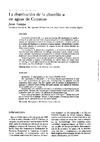Please use this identifier to cite or link to this item:
https://accedacris.ulpgc.es/handle/10553/673
| DC Field | Value | Language |
|---|---|---|
| dc.contributor.author | Aristegui, J. | es |
| dc.contributor.other | Facultad de Ciencias del Mar | es |
| dc.contributor.other | Departamento de Biología | es |
| dc.date.accessioned | 2009-10-08T02:31:00Z | - |
| dc.date.accessioned | 2018-03-02T09:45:54Z | - |
| dc.date.available | 2018-03-02T09:45:54Z | - |
| dc.date.issued | 1990 | es |
| dc.identifier.issn | 0074-0195 | es |
| dc.identifier.other | 868 | es |
| dc.identifier.uri | https://accedacris.ulpgc.es/handle/10553/673 | - |
| dc.description.abstract | La concentración de la clorofila a en aguas de Canarias debe interpretarse con cautela a la hora de ser utilizada como índice de productividad de un área determinada, pues a menudo sólo representa el excedente del consumo del zooplancton. Este hecho, junto con la tendencia del fitoplancton a agregarse formando máximos subsuperficiales o profundos, pueden dificultar la interpretación de imágenes de color del océano obtenidas mediante sensores remotos. Las abundancias de fitoplancton y zooplancton se correlacionan positivamente durante los meses menos productivos. Sin embargo, entre marzo y junio, cuando se alcanzan las máximas concentraciones de zooplancton, la relación se invierte y biomasa de fitoplancton pasa a depender esencialmente del control ejercido por el pastaje. Aunque en general se aprecie un ligero gradiente de aumento de clorofila a hacia las islas más orientales y cercanas al afloramiento, los valores medios son siempre bajos (< 0.25 mg.m-3) y las diferencias no son tan definitivas como ocurre con el zooplancton, que muestra una clara distribución en manchas. | es |
| dc.description.abstract | The concentration of chlorophyll a in the Canary Islands waters should not be used as an index of productivity of a given area, since frequently only represents what the zooplankton doesn’t graze. This fact, together with the tendency of phytoplankton to aggregate in subsurface layers forming chlorophyll maxima, may difficult the interpretation of satellite ocean color images. Phytoplankton and zooplankton abundances are positively correlated during the less fertile months. However, this relationship is inverted between March and June, when zooplankton peaks and controls very efficiently the phytoplankton crop. Mean values of chlorophyll a are generally low (0.25 mg.m-3) during most of the year all around the Archipelago. However, a slight gradient of increasing content in this pigment may be appreciated towards the eastern islands. | en |
| dc.language | spa | es |
| dc.source | Boletín del Instituto Español de Oceanografía [ISSN 0074-0195], v. 6 (2), p. 61-72 | es |
| dc.subject.other | Clorofila a | es |
| dc.subject.other | Océano | es |
| dc.subject.other | Canarias | es |
| dc.title | La distribución de la clorofila a en aguas de Canarias | es |
| dc.type | info:eu-repo/semantics/article | es |
| dc.type | Article | es |
| dc.contributor.contentdm | Oceanografía biológica | es |
| dc.contributor.contentdm | Biología | es |
| dc.contributor.contentdm | Facultad de Ciencias del Mar | es |
| dc.identifier.absysnet | 189218 | es |
| dc.identifier.crisid | 2728 | - |
| dc.rights.accessrights | info:eu-repo/semantics/openAccess | es |
| dc.type2 | Artículo | es |
| dc.identifier.ulpgc | Sí | es |
| item.grantfulltext | open | - |
| item.fulltext | Con texto completo | - |
| crisitem.author.dept | GIR IOCAG: Oceanografía Biológica y Algología Aplicada | - |
| crisitem.author.dept | IU de Oceanografía y Cambio Global | - |
| crisitem.author.dept | Departamento de Biología | - |
| crisitem.author.orcid | 0000-0002-7526-7741 | - |
| crisitem.author.parentorg | IU de Oceanografía y Cambio Global | - |
| crisitem.author.fullName | Arístegui Ruiz, Javier | - |
| Appears in Collections: | Artículos | |
Items in accedaCRIS are protected by copyright, with all rights reserved, unless otherwise indicated.
